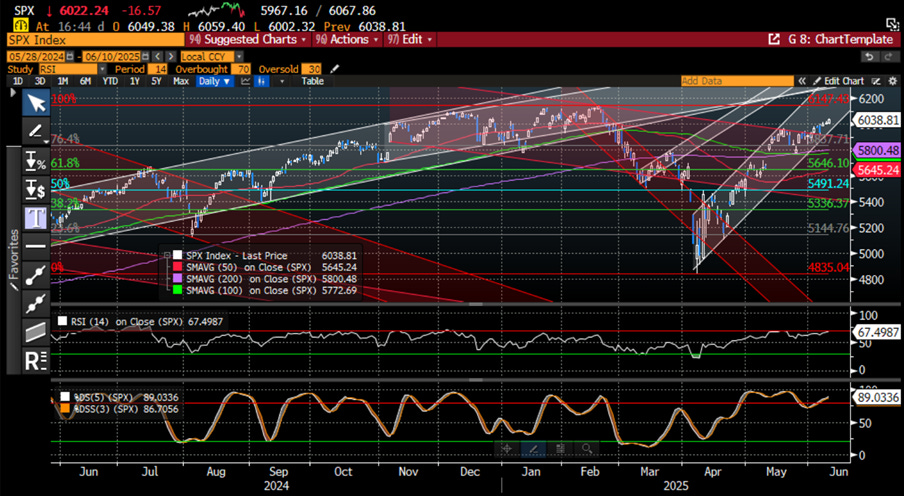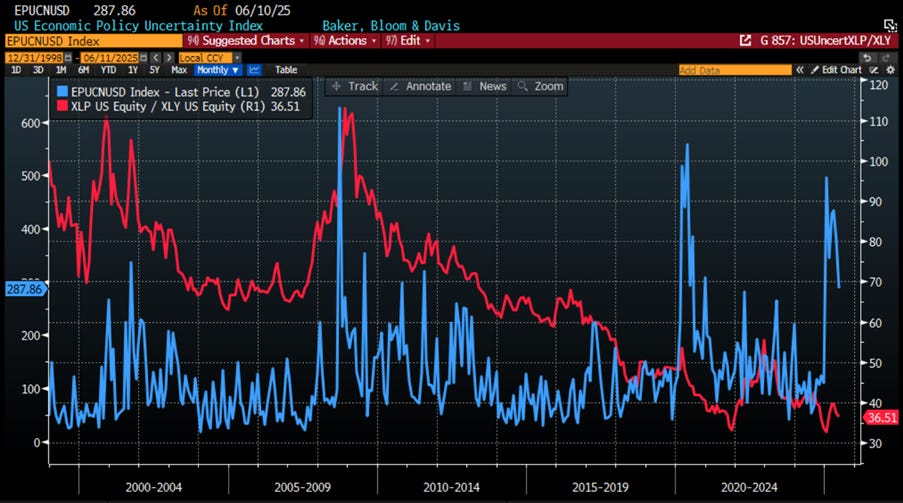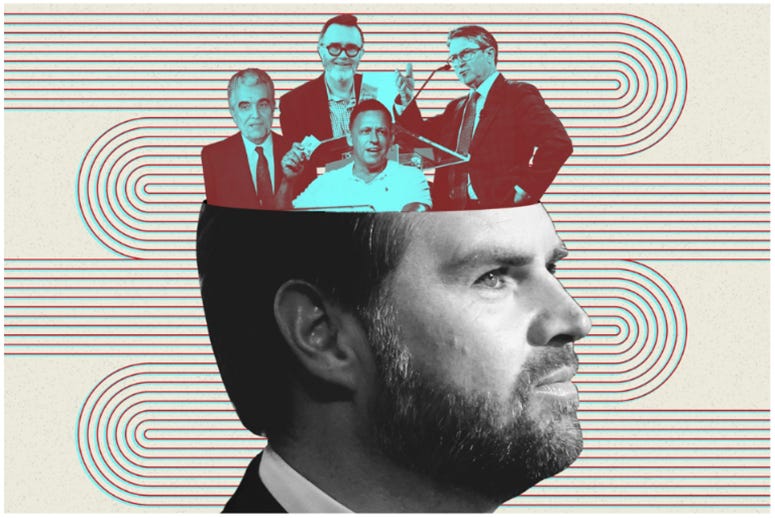What’s behind the numbers?
The fifth CPI print of this grand Jubilee Year tiptoed in with a dainty +0.1% MoM rise—shy of the +0.2% forecast and clearly not trying to make headlines. Year-on-year inflation strutted in at +2.4%, nailing expectations like a student who memorized just the summary slide, and edging up from April’s +2.3%. Energy played the deflation superhero again (cape and all), goods continued their emo phase in deflationary gloom, while food prices bounced back like a toddler on sugar. Services, meanwhile, took centre stage with their biggest monthly leap since last February—back when tariffs and immigration crackdowns were still just a twinkle in an executive order’s eye.
Core CPI tiptoed up just 0.1% in May—well below the predicted +0.3% and even softer than April’s +0.2%. On a YoY basis, it crept in at 2.8%, technically matching expectations while still clinging to its “lowest since March” trophy like a participation award. Core services, which make up a buffet-sized 76% of the index, took a breather, slipping from +2.73% to +2.70%. Meanwhile, core goods decided to surprise everyone by being inflationary for the second month in a row—because apparently, they missed the memo on disinflation. And for the trivia buffs: this marks the 60th consecutive month of rising core CPI. But no worries—nobody’s counting. Except economists. And investors. And central banks. And probably your grocery bill.
A glimmer of hope for the “inflation is totally over, we swear” crowd: Owners' Equivalent Rent—the inflation zombie that just won’t die—managed to rise only 4.2% year-on-year in May. That’s down a whole tenth from April’s 4.3%, making it the “coolest” reading since January 2022. So yes, inflation is clearly defeated... as long as you squint, tilt your head, and ignore rent, food, and reality.
Even less “encouraging” for the inflation-is-dead crowd: SuperCore CPI—aka core services minus housing, or what the Fed actually watches when it’s pretending to look busy—climbed to 2.86% year-on-year in May. That’s up from April’s 2.74% and right back to March levels, before the world got “tarrified” and everything started costing extra for the new ‘tariff tax’. So much for the victory lap.
Market reactions.
U.S. stocks initially threw a little celebration over the “meh” CPI report—balloons, confetti, maybe even a cupcake—only to remember they were bumping up against some serious technical resistance and looking a tad overcaffeinated. Cue the reversal. The Dow Jones, ever the sensible uncle in the family, outpaced the more excitable S&P 500 and Nasdaq 100 for the day.
The cooler-than-expected U.S. CPI gave markets a fleeting sugar rush—but alas, it wasn’t enough to resurrect faith in the ever-dithering Fed actually pulling the rate-cut trigger this year. Traders are still clinging to the dream of two cuts by December, with a 79% chance of a September move. But let’s be honest—once summer’s over and reality sets back in, that fantasy will probably melt faster than an ice cream cone in Death Valley.
The dollar’s doing its best comeback impression, building on a shiny double bottom pattern like it’s auditioning for a technical analyst’s dream chart. With capital flows boomeranging back to the U.S., the greenback looks set to flex its muscles against its fiat peers—higher highs, higher lows, and maybe even a smug victory lap or two in the months ahead.
Gold remains still stuck in that glamorous consolidation party it’s been attending since its all-time high on April 22nd—printing lower highs like it’s on a discount sale and flirting with lower lows just to keep things interesting.
Thanks to a cooler-than-expected CPI report, the U.S. 10-year yields are catching their breath below 4.5%, lounging like a marathon runner at the water station—fully aware the next leg of the reflationary drama is just around the corner, and it’s bringing those long-dated yields a fresh uphill climb.
Thoughts.
May’s CPI report—the first full month of data since the world officially got ‘tarrified’—has confirmed what everyone with a grocery bill already knew: March's deflationary dip was just a statistical burp. And now, someone’s got to pick up the tab for the tariff tax—it's either the consumer or the guys making their stuff. Welcome to the Trump-Re-Flation era, where trade policy comes with a price tag and a punchline. While the ‘Manipulator in Chief’ and the ‘Central Banker in Chief’ high-five each other for “winning,” the composite of US inflation index keeps quietly doing laps—now up 3.28% year-on-year. That magical 2% target? Still as real as a unicorn riding a flying Fed spreadsheet.
US Umbrella inflation Index (Average of CPI; Core CPI; PPI; Core PPI; Core PCE, 1-year consumer inflation expectations)
Rather than clinging to the fairy tale that 2% inflation is just around the corner (before the end of the Jubilee Year—give or take a miracle), savvy investors, clearly more grounded than the army of PhDs at the Fed and on Wall Street, know better. Especially with that “most beautiful word in the English language” (tariffs, of course) still waiting to hit consumer wallets like a delayed punchline.
Anyone with a passing familiarity with base effects can do the math:
To hit 2% by end-2025, CPI would need to tiptoe in at under 0.1% monthly—basically a statistical unicorn.
If monthly prints creep up to 0.2% or more, we’re looking at year-end CPI anywhere between 2.6% and 5.5%.
In that case, the FED may have to sheepishly admit that easing policy during an inflationary boom wasn’t exactly a masterclass in central banking—unless the goal was to win the partisan policy limbo contest.
Savvy investors know inflation isn’t rocket science—it comes from shortages, strong demand, and fading trust in public institutions. So, when tariffs, trade wars, and U.S. imperial chest-thumping fuel all three, it’s a recipe for rising prices and collapsing confidence. If Trump’s policies trigger inflation or another warmongering misadventure, his support will vanish faster than a campaign promise.
At the end of the day, nobody needs a PhD in economics—or even a decent attention span—to grasp this: inflation’s three ugly heads (shortages, demand, and distrust) all feed off one thing—uncertainty. When investors and consumers can’t make heads or tails of government policy (or whether the people writing it are even awake), trust erodes faster than a campaign promise. And surprise, surprise—when confidence crumbles, inflation follows. So yes, rising policy chaos = rising CPI. It’s practically economic gravity—with more truth social posts.
US Economic Policy Uncertainty Index (blue line); US CPI YoY Change (red line).
In this kind of policy circus, where uncertainty reigns supreme, it doesn’t take an MBA to figure out that business owners will slam the brakes on hiring and capex. And when spending stalls and layoffs creep in, guess what follows? A nice spike in the misery index. So yes, rising uncertainty doesn’t just dent confidence—it eventually lands everyone in a full-blown economic hangover.
US Economic Policy Uncertainty Index (blue line); US Misery Index (red line).
As uncertainty and misery rise—and inflation proves stickier than ever—investors need to revisit which assets to hold and, more importantly, which to avoid in a chaos-driven business cycle. In times like these, it's no surprise that among the four asset classes in the Permanent Portfolio, contracts (bonds and cash) continue to underperform property (stocks and gold). After all, when trust in public institutions erodes, so does the value of the IOUs they issue. In this context, gold doesn't just shine—it outperforms both bonds and cash when uncertainty takes the wheel.
US Economic Policy Uncertainty Index (blue line); Relative Performance of Gold price in USD terms to Bloomberg US 1-3 Months Bills Index (red line).
Savvy investors know the drill: in a stickier-for-longer inflation environment and rising chaos, growth stocks flop—just look at the Nasdaq in 2022. The real signal? Gold outpacing bonds and breaking above its 7-year moving average. In this kind of market, it’s Dow over Nasdaq, energy producers over energy-hungry tech, and real assets over the empty promises of untrustworthy governments.
Upper panel: Gold to Bond ratio (blue line); 7-year moving average of the Gold to Bond ratio (red line); Lower Panel: Relative performance of S&P 500 energy sector to S&P 500 IT sector (yellow line).
In a sticky inflation environment—aka the "fun" part of the economic cycle where everyone’s miserable—it’s hardly shocking that consumer stocks take a hit. When budgets get squeezed, even the most loyal shoppers will gladly swap their overpriced, aristocratic ‘butt push up tights’ for, you know, actual food. So yes, maybe skip the retail darlings and stick to things people can’t eat their way out of among consumer related stocks.
US Economic Policy Uncertainty Index (blue line); Relative Performance of S&P 500 Consumer Staples Index to S&P 500 Consumer Discretionary Index (red line).
As consumers snap back to reality and start spending on what keeps them alive—rather than what looks good on Instagram—it’s no wonder they're flocking to Walmart. In a world where Americans across every income bracket are paying more and getting less, Walmart’s “everyday low prices” suddenly look like a luxury in themselves. So, it’s no surprise that the retail king of frugality keeps outshining the U.S. luxury sector. When uncertainty rises and wallets shrink, Walmart becomes less of a store—and more of a lifestyle.
US Economic Policy Uncertainty Index (blue line); Relative Performance of Walmart to S&P 500 Luxury Sector (red line).
The recent feud between the ‘Manipulator In Chief’ and his ‘Tech gig Rasputin’ isn’t about hurt feelings—it’s an AI turf war thinly veiled by headlines about EV subsidies. Never mind that Musk was demanding subsidy cuts just last July; the real drama traces back to Peter Thiel grooming J.D. Vance for power, from VC darling to senator to ‘Vice Premier In Chief’, all while pushing Curtis Yarvin’s “Dark Enlightenment” vision like it’s gospel. This isn’t chaos—it’s choreography. The PayPal Mafia isn't disrupting anymore; they’re consolidating. Yarvin himself showed up at Trump’s Coronation Ball on January 20th 2025—because every soft coup deserves a tuxedo. Later, he told Politico that Trump’s first term helped lobbyists more than voters and shrugged that Congress runs the country anyway. His fix? Put the Fed under White House control. Because why stop at monarchy when you can own the money printer too?
Before unpacking boxes at Number One Observatory Circle, J.D. Vance had already flashed his ideological credentials. On a 2021 podcast, he gave a casual shoutout to none other than Curtis Yarvin—yes, the monarchist blogger behind “Dark Enlightenment.” Vance even offered Trump some friendly advice: “Fire every single midlevel bureaucrat… replace them with our people.” So much for draining the swamp—apparently, the plan is to restaff it with Yarvin fanboys, enriching the PayPal Mafia, of course.
Vance didn’t climb the political ladder solo. With Peter Thiel bankrolling his venture into politics, and Elon Musk now bizarrely calling for Trump’s third impeachment, this sudden intra-MAGA drama feels less like a real feud and more like a tech-scripted transition plan. No need for tinfoil hats or Black Eye Club detours—the PayPal Mafia is very real, and so is the Dark Enlightenment playbook. If Trump was the battering ram, Vance may be the chosen architect. The only real mystery left is whether anyone realizes the next phase of the takeover is already underway, as the tech ‘Trojan Horses’ repopulate the Washington swamp.
Bottom line: Any investor with half a brain can see it: the 47th president's inner circle isn’t draining the swamp—they're just refilling it with better-dressed grifters. The new regime talks populism but walks plutocracy, squeezing the average American while cozying up to the same forever-club of oligarchs wearing tech hoodies, who’ve never once had the people's interests at heart—in the US or abroad. Freedom? Only for those who follow the rulebook written by billionaires from Silicon Valley.
Meanwhile, the U.S. doubles down on tariffs as if economic isolationism ever ended well. The fantasy that trade barriers will “bring jobs back” ignores basic history: America’s trade deficit isn’t because of China—it’s because the U.S. chose to become a consumption-addicted debtor state after WWII. Multinationals offshored for profit. Imports just filled the vacuum.
What the US needs isn’t a tariff tantrum—it’s deregulation, real tax reform, and fiscal restraint. But that won’t happen while the political class is too busy managing its personal portfolios. For investors, the message is blunt: empires in decline tend to self-implode under the weight of war, debt, and delusion. In times like these, hard assets—physical gold, select equities—remain the go-to shelters. Long bonds? Only if you're feeling generous toward the Treasury's spending addiction.
In the end, the tariff crusaders won’t be remembered as patriots. They’ll be the ones who helped script the final chapter of American economic supremacy.
Key takeaways.
May’s CPI—sure to comfort those already drafting inflation’s obituary—got its chill vibes mostly from cheaper energy. But don’t get too cozy: all it takes is one geopolitical sneeze in the Middle East for prices to spike faster than you can say “peace talks.”
At the core level, goods inflation has decided it’s not done partying, while service costs remain as clingy as ever—like that one guest who just won’t leave the party.
While the ‘Trump-Re-Flation’ gains steam, fuelled by tariffs and tighter labour markets, the real question isn’t if inflation rises, but who picks up the tab: businesses trying to protect margins, or consumers bracing for sticker shock.
With the American economy still reliant on government handouts, the rollout of tariffs is bound to ignite the ‘Trump Stagflation.’
While the FED may downplay base effects, hitting 2% inflation by end of 2025 is quickly turning into a phantasmagorical illusion.
Inflation stems from shortages, demand, and declining confidence, all exacerbated by tariffs and trade barriers that stifle free mercantilism.
In an inflationary bust, investors need to understand that protecting their wealth involves avoiding long-dated government bonds and focusing on a combination of equities from companies that can maintain pricing power with strong balance sheets and robust business models and physical gold as THE antifragile asset.
As stagflation rather than recession worsens in the next few months, investors should prepare their portfolios for HIGHER volatility.
Gold and silver are eternal hedge against "collective stupidity" and government hegemony, both of which are abundant worldwide.
In this context, investors should also remain prepared for dull inflation-adjusted returns in the foreseeable future.
With the S&P 500-to-gold ratio below around its 7-year moving average for more than 4 months, investors should remain aware that, while the US economy is currently in an inflationary boom, it may be only 6 to 9 months away from shifting into an inflationary bust (i.e., stagflation). STAGFLATION will be painful for investors who haven't prepared their portfolios for this scenario. In this environment, people will buy even less for even more, and it will be challenging for those still blindly following Wall Street's ‘Forward Confusion’ narrative of seeking refuge in long dated fixed income papers and government bonds. Physical GOLD remains the only antifragile asset to thrive during an inflationary bust.
Bottom line: As everyone knows, history shows that collapsing public confidence, fuelled by political instability and wars, leads to economic turmoil and this decade will be no different, as the ‘Trump-Re-Flation’, morphs into the 'Trump Stagflation,' which will force everyone, from billionaires to everyday citizens, to pay even more for even less.
As the world sails in tariff shock, investors should favour low-leverage companies with strong EPS and FCF growth, prioritizing energy producers over consumers as the U.S. joins the global inflationary bust, soon known as 'Trump Stagflation.' In fixed income, avoid long-dated bonds, especially government debt beyond six months, and actively manage cash through sub-12-month investment-grade corporate bonds. Ultimately, replacing long-term bonds with more than 25% allocation to physical gold, silver, and hard commodities will provide antifragile protection, as scarcity premiums rise amid a looming sovereign debt crisis, first in Japan and Europe, then inevitably in the U.S., where the 47th president, like his predecessors, repeats failed policies while expecting different results. Indeed, everyone should by now know that consumers and businesses always lose amid trade wars. The tariff game has become tit-for-tat, with nations continually “retaliating” despite the reality that these measures are hurting their own economies.
If this research has inspired you to invest in gold and silver, consider GoldSilver.com to buy your physical gold:
https://goldsilver.com/?aff=TMB
Disclaimer
The content provided in this newsletter is for general information purposes only. No information, materials, services, and other content provided in this post constitute solicitation, recommendation, endorsement or any financial, investment, or other advice.
Seek independent professional consultation in the form of legal, financial, and fiscal advice before making any investment decisions.
Always perform your own due diligence.




























by President Trump not being able (or unwilling) to control Netanyahu he may get a spike in inflation - especially if Iran respnds to today"s attack by blocking the straits, that would send the oil price well over $100 and result in energy caused inflation (shortage) - so much for energy enduced defalation...
BTW, interesting comment re Tech-scripted transition plan...Thiel, the VP, Tech gig Rasputin... and yes, you are totally spot on that deregulation, real tax reform and fiscal restraint is the path.